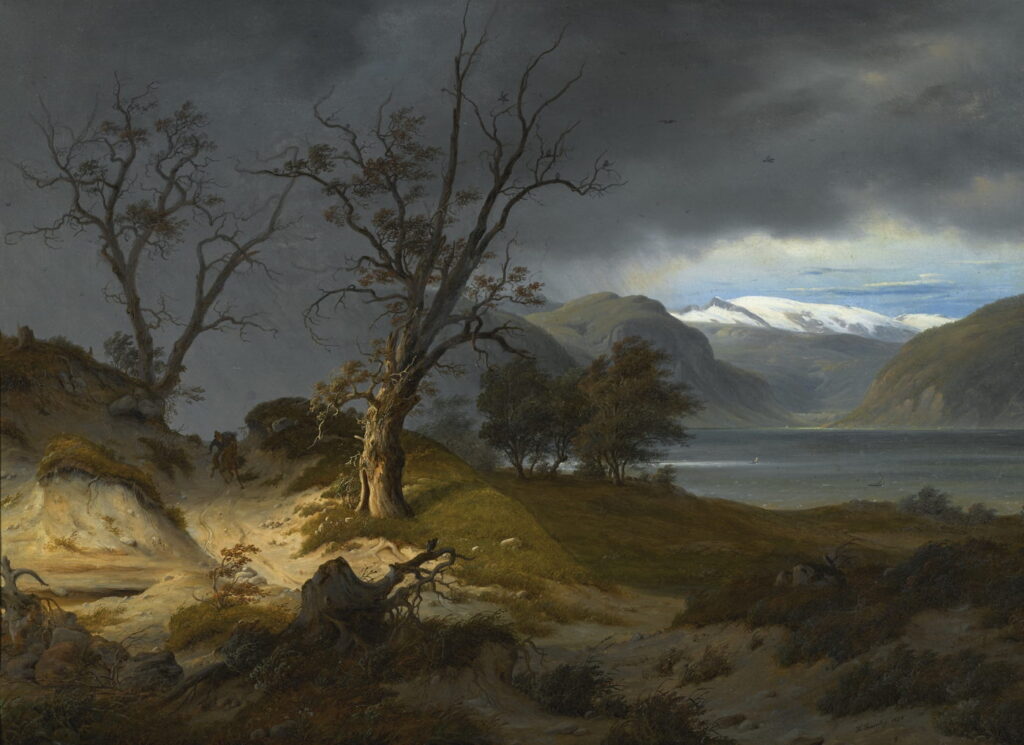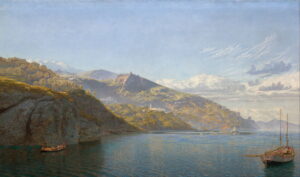Sea of Mists: Pupils, Thomas Fearnley 1

As Thomas Fearnley’s name suggests, he was of British origins, but in the middle of the eighteenth century his grandfather moved to Norway to conduct his trading business there. His grandson Thomas was born in south-east Norway in 1802. Seventeen years later he started his training as an artist, progressing from the Norwegian National Academy of Craft to the Art Academy in Copenhagen in 1821, then on to its sister academy in Stockholm in 1823.
By then, Fearnley had proved himself proficient enough to be commissioned by Crown Prince Oscar of Norway and Sweden. After touring the Nordic countries painting their landscapes, in 1828 he went to Germany, and the following year became a student of JC Dahl in Dresden.
Thomas Fearnley (1802–1842), The Bridge of Hauge outside Arendal (1829), oil on canvas, 57 x 73.5 cm, Nasjonalmuseet for kunst, arkitektur og design, Oslo, Norway. Wikimedia Commons.
Fearnley’s nocturne of The Bridge of Hauge outside Arendal from 1829 is an example of German Romanticism as practised by Caspar David Friedrich and JC Dahl, here set in a rugged Norwegian landscape. Arendal is in the far south of Norway, on the northern coast of the Baltic Sea.
Thomas Fearnley (1802–1842), Winter Landscape (1829), oil on canvas, 10 x 13 cm, location not known. Wikimedia Commons.
His bleak and barren Winter Landscape from the same year apparently shows a scene near Dresden in a small oil sketch, a technique that JC Dahl no doubt actively encouraged.
The following year, Fearnley painted one of his first landscapes with a wanderer. By all accounts, Fearnley himself was a portly man, who would have looked quite different to the figures that keep appearing in his later paintings. It seems reasonable to conclude that this traveller, viewer, and artist was Fearnley’s artistic alter ego, a Rückenfigur typical of German Romantic paintings.
Thomas Fearnley (1802–1842), Landscape with a Wanderer (1830), oil on canvas, 49 x 66.5 cm, Nasjonalgalleriet, Oslo. Wikimedia Commons.
He often appears wearing a distinctive hat, sometimes a top-hat, or the red cap of Landscape with a Wanderer from 1830, shown in the detail below.
Thomas Fearnley (1802–1842), Landscape with a Wanderer (detail) (1830), oil on canvas, 49 x 66.5 cm, Nasjonalgalleriet, Oslo. Wikimedia Commons.
From Dresden, Fearnley went on to Munich in 1830, then two years later started life as a wanderer himself, touring through France, Britain and reaching Venice later in 1832.
Thomas Fearnley (1802–1842), A Terrace in Amalfi in Moonlight (1834), oil on paper on cardboard, 26 x 30 cm, Nasjonalgalleriet, Oslo, Norway. Wikimedia Commons.
He painted A Terrace in Amalfi in Moonlight in 1834, another atmospheric nocturne. Amalfi is a town on the south-west coast of Italy, set amid a famously scenic coastline. Fearnley uses the cunning device of the awning to hide the direct light of the moon, in what must have been a plein air sketch, executed at speed.
Thomas Fearnley (1802–1842), The Painter and the Boy (c 1834), oil on paper mounted on canvas, 26.5 × 37 cm, Nasjonalgalleriet, Oslo. Wikimedia Commons.
A couple of times, Fearnley’s painter assumes importance, as in The Painter and the Boy (c 1834) above. This view of the Italian coast was most probably painted en plein air over a period of a few days, the figures being added late during the process. The artist with his back to the viewer doesn’t appear bulky enough to be Fearnley, cannot be identified as any real painter, and must be presumed to be this alter ego.
If the Painter and the Boy themselves are part of the motif, Fearnley still adorns the ground with accessories. The detail below shows well over a dozen, each carefully worked during the limited time available.
Thomas Fearnley (1802–1842), The Painter and the Boy (detail) (c 1834), oil on paper mounted on canvas, 26.5 × 37 cm, Nasjonalgalleriet, Oslo. Wikimedia Commons.
Thomas Fearnley (1802–1842), Rider in a Landscape (1834), oil on canvas, 53.5 x 74.5 cm, Private collection. Wikimedia Commons.
Fearnley’s Rider in a Landscape from the same year is clearly set in the fjords of Norway. Its lone rider is whipping their horse on as they descend a rough track leading down to shore of the fjord at the right. Behind them the world has turned dark grey with the heavy rain of an approaching storm, while the sun still shines on the ice-capped mountains in the far distance.
Thomas Fearnley (1802–1842), Sunrise in the Wengeralp (sketch) (1835), oil on paper mounted on canvas, 24.5 x 30 cm, The Fitzwilliam Museum, Cambridge, England. Wikimedia Commons.
Fearnley painted this detailed oil sketch of Sunrise in the Wengeralp in 1835, in preparation for a larger finished work that he completed three years later. This is located above Wengen in the Bernese Oberland in Switzerland, and is not far from Grindelwald and its glacier, which he was to paint in the coming years.
Reference
Sumner, Ann, and Smith, Greg (eds) (2012) In Front of Nature, The European Landscapes of Thomas Fearnley, Barber Institute of Fine Arts. ISBN 978 1 907804 10 6.




